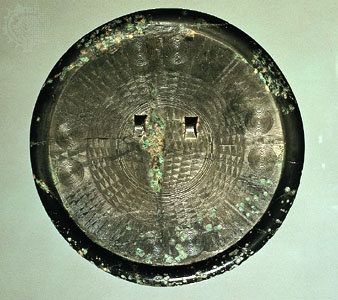bronze work
implements and artwork made of bronze, which is an alloy of copper (copper work), tin, and, occasionally, small amounts of lead and other metals.
 Bronze first came into use before 3000 BC but was rare until an extensive trade in tin developed following the discovery of large tin deposits, such as those in Great Britain (United Kingdom). Until the development of iron about 1000 BC, bronze was used widely in weapons, armour, tools, and other implements. Even in modern times, bronze is still used for certain kinds of machine parts. Bronze is not as malleable as copper or silver, nor is it readily forged or chased. Its unique casting properties, however, have assured its continued preeminence in cast sculpture.
Bronze first came into use before 3000 BC but was rare until an extensive trade in tin developed following the discovery of large tin deposits, such as those in Great Britain (United Kingdom). Until the development of iron about 1000 BC, bronze was used widely in weapons, armour, tools, and other implements. Even in modern times, bronze is still used for certain kinds of machine parts. Bronze is not as malleable as copper or silver, nor is it readily forged or chased. Its unique casting properties, however, have assured its continued preeminence in cast sculpture.As molten bronze solidifies, it expands, assuring the faithful reproduction of every detail in the mold. As the solidified bronze cools further, it contracts slightly, easing removal of the sculpture from the mold. Bronze sculpture is often esteemed for the natural patina that forms over time as the surface of the bronze tarnishes. The thin, uniform patina of green and blue copper compounds confers not only aesthetic qualities but also a measure of protection to the underlying metal. In the Middle Ages, bronze found extensive uses in churches and cathedrals, both for bronze doors and for bronze vessels, candlesticks, reliquaries, and other liturgical implements. Bronze also was used in households for basins and ewers, candlesticks and chandeliers, and fittings for furniture as late as the 19th century. Bronze work was often decorated, by such techniques as engraving, inlaying, enameling, and gilding.
- constitutiones principum
- Constitution of Medina
- Constitution of the United States
- Constitution of the United States of America
- Constitutions of Clarendon
- constitution theory
- constringence
- construction
- Constructivism
- consubstantiation
- consul
- Consulate of the Sea, Book of the
- consumer advocacy
- consumer credit
- consumer good
- consumer price index
- Consumer Prices in OECD Countries, Table
- Consumer Prices in OECD Countries, Table 1
- Consumer Prices in OECD Countries, Table 2
- Consumer Prices in OECD Countries, Table 3
- Consumer Prices in OECD Countries, Table 4
- Speusippus
- Speyer
- Spey, River
- sphagia